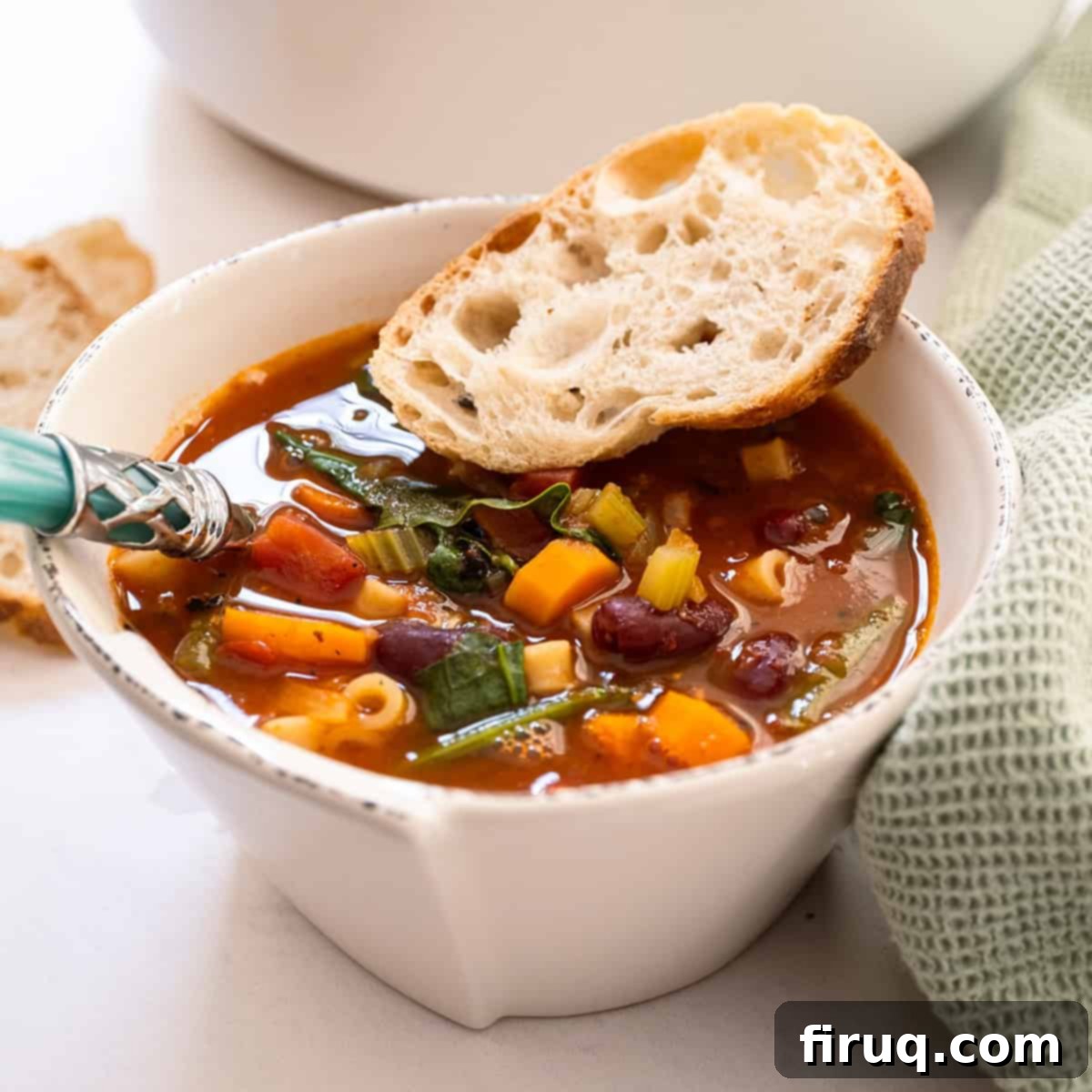Classic Italian Minestrone: A Hearty & Timeless Vegetable Soup Recipe
There’s nothing quite like a steaming bowl of homemade soup to bring comfort and warmth, and few soups are as beloved and universally appealing as Classic Italian Minestrone. This vibrant vegetable soup, brimming with fresh ingredients and robust flavors, is a cornerstone of Italian culinary tradition. Far from being just a simple dish, Minestrone boasts a rich history, evolving over centuries to become the hearty, versatile meal we cherish today.
Our rendition of this timeless recipe is packed with nutritious vegetables like tender carrots, crisp celery, fresh spinach, and vibrant green beans, alongside wholesome kidney beans and ditalini pasta. It’s a truly satisfying dish that can serve as a light lunch or a substantial main course. Pair this delightful Minestrone with a flavorful sandwich such as My Big Fat Greek Chicken Burger or a comforting Gruyere Grilled Cheese for a complete and utterly delicious meal.
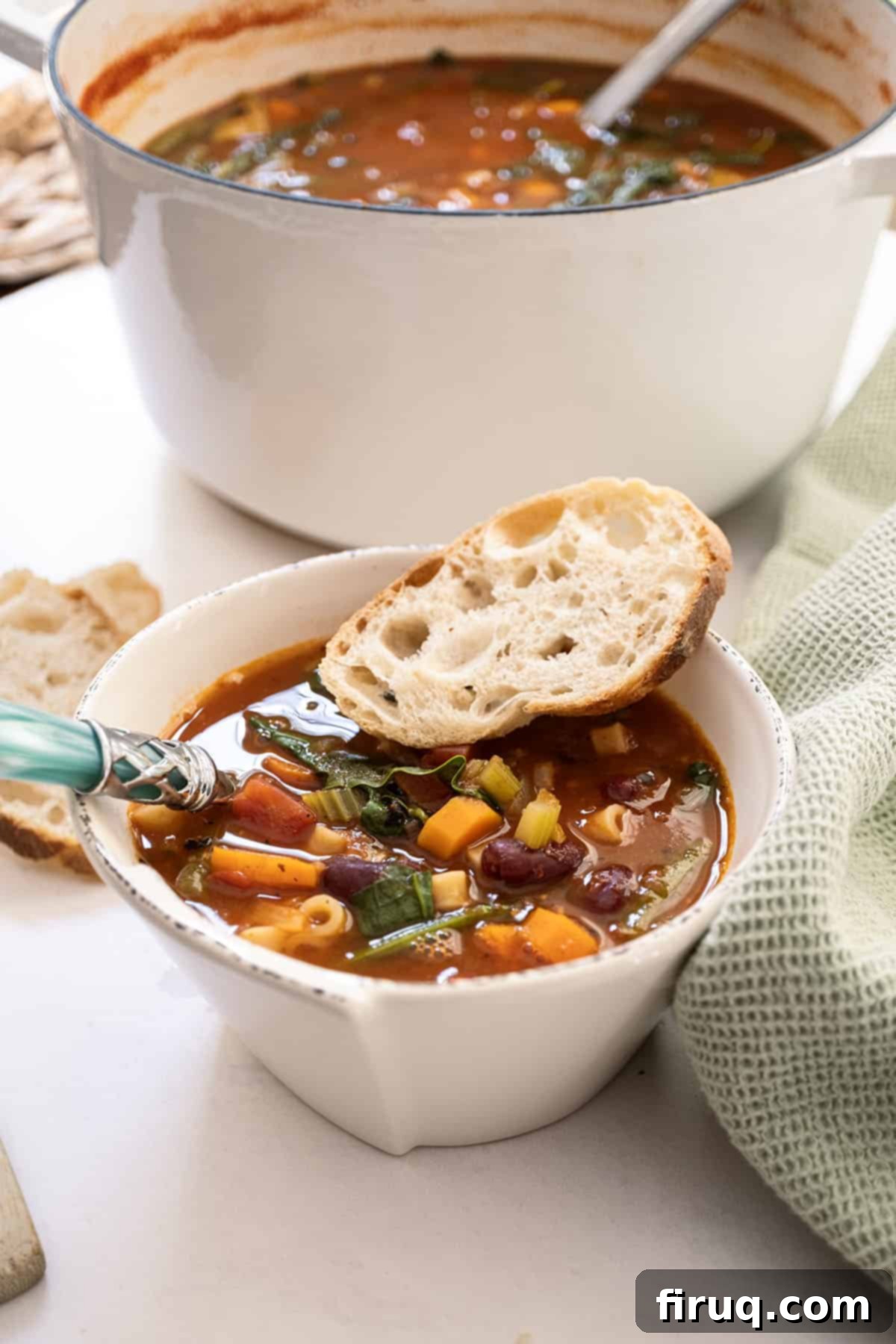
Craving more timeless Italian soup recipes? Don’t miss our indulgent Zuppa Toscana, the comforting Pasta Fagioli with Spinach, or the ever-popular Italian Wedding Soup! Each offers a unique taste of Italy, perfect for any season.
Before diving into the recipe, here’s a quick navigation to help you find exactly what you’re looking for:
[feast_advanced_jump_to]
The Enduring History of Minestrone: A Soup Through the Ages
When we talk about Classic Italian Minestrone, we’re not just referring to a beloved recipe; we’re delving into a culinary legacy that predates even the grandeur of the Roman Empire. This remarkable soup has records tracing back to the 2nd century B.C., making it one of the oldest dishes still enjoyed today. Originally, Minestrone was a humble “poor man’s soup,” crafted from whatever seasonal vegetables and grains were available, reflecting a resourceful approach to cooking that maximized flavor and nutrition from simple ingredients.
The name “Minestrone” itself offers a clue to its origins, deriving from “minestra,” the Italian word for soup. It’s a term that signifies a substantial, hearty meal in a bowl, often served as the main course. Early versions were far simpler than today’s, lacking many of the ingredients we now consider staples. For instance, written recipes describing Minestrone exist as early as 30 A.D., with a notable mention of a dish called Polus in the Roman cookbook “De Re Coquinaria,” which many food historians believe to be a direct ancestor of modern Minestrone. This ancient connection is fascinating, much like our exploration of historical recipes such as Fennel Chicken Thighs in Red Wine, inspired by similar historical culinary texts.
The Roman conquest of Italy introduced a plethora of new foods and vegetables to the Italian diet. While this period was certainly complex for the original Italians, it undeniably broadened their culinary palette. Ingredients like many types of beans, new grains, and diverse vegetables gradually found their way into Minestrone, enriching its flavors and textures. It was centuries later, in the 1500s, with the arrival of tomatoes from the New World and their eventual widespread cultivation in Italy, that Minestrone truly began to take on its familiar reddish hue and tangy depth. This historical evolution highlights the dynamic nature of traditional cooking.
While many Italian cooks hold a deep reverence for strict culinary traditions, I believe in embracing the evolution of cuisine. Minestrone itself is a testament to this, adapting ingredients as they became available. For example, tomatoes, now indispensable, weren’t even present in its earliest forms. My approach balances respect for its heritage with a willingness to utilize the wonderful ingredients and knowledge we have today, ensuring the spirit of a classic dish endures while benefiting from modern accessibility and taste preferences. This adaptability is what has kept Minestrone relevant and delicious for millennia.
Ingredient Notes and Smart Substitutions for Your Minestrone
Crafting the perfect Minestrone starts with understanding your ingredients. This soup is wonderfully forgiving and adaptable, making it a fantastic way to use up whatever fresh produce you have on hand. Here’s a closer look at the key components and how you can personalize them:
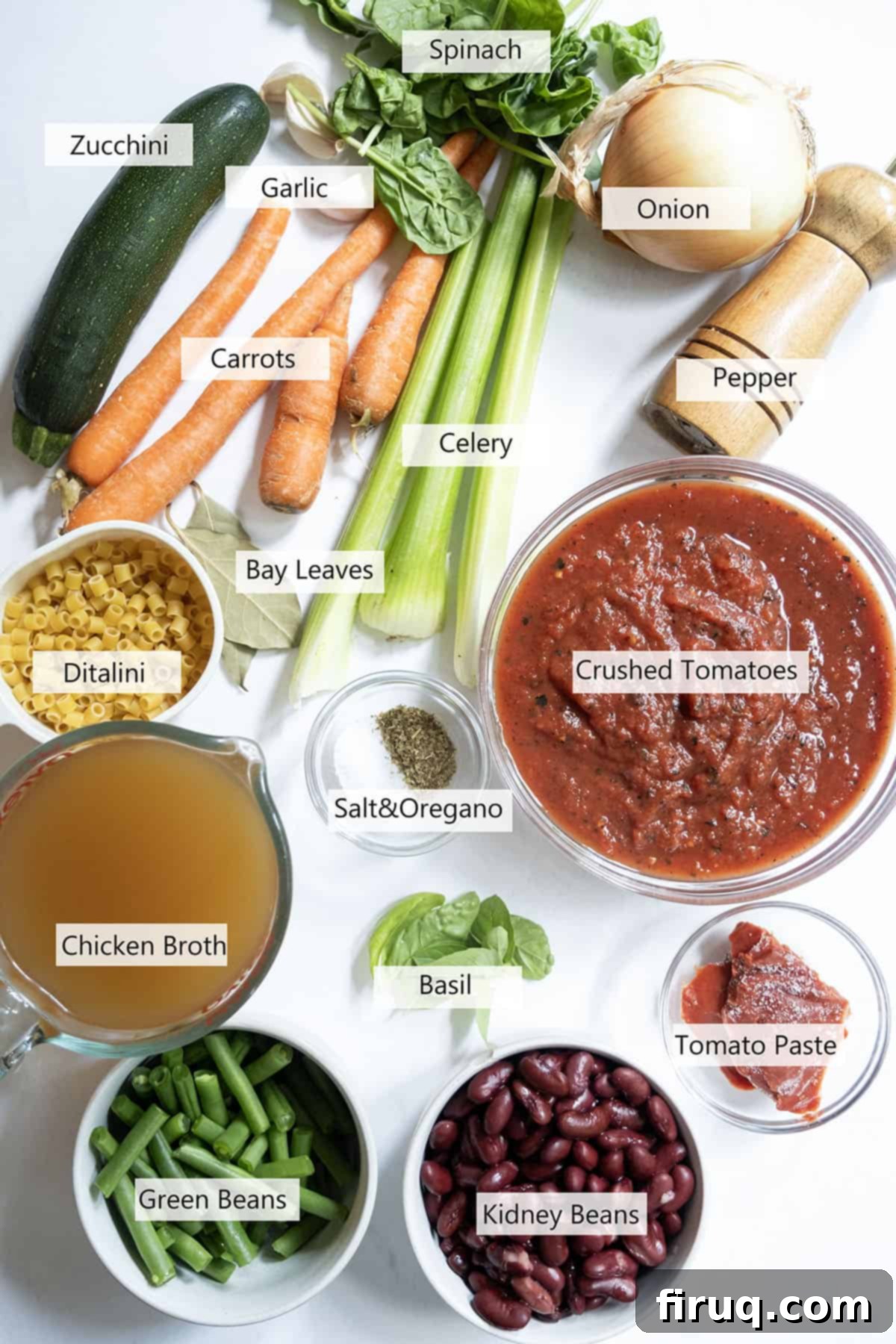
- Broth. While Minestrone is traditionally a vegetable-forward dish, many recipes, including ours, sometimes call for chicken broth for a richer, more savory base. If you prefer to keep it vegetarian or vegan, opt for a high-quality vegetable broth. My personal preference leans towards chicken broth if buying store-bought, as I find boxed vegetable broths often lack depth. However, if I have an abundance of vegetable scraps saved in my freezer, I’ll happily make my own homemade vegetable broth – it’s incredibly flavorful and a great way to reduce waste.
- Vegetables. The beauty of Minestrone lies in its adaptability, much like our Pasta Primavera with Broccoli and Asparagus. You can truly use whatever seasonal vegetables you have on hand. The foundational “soffritto” (Italian mirepoix) of carrots, celery, and onion is non-negotiable, forming the aromatic base for the soup. Beyond these, green beans, kidney beans, spinach, and zucchini are classic additions that provide a wonderful balance of textures and nutrients. Feel free to experiment with other vegetables like kale, peas, potatoes, cabbage, leeks, bell peppers, or even butternut squash. Just ensure they are chopped to a similar size for even cooking.
- Tomato Paste. This seemingly small ingredient plays a massive role in building a deep, rich umami flavor in your Minestrone. The secret is to caramelize it. When tomato paste is allowed to cook directly on the bottom of the pot, its natural sugars undergo a Maillard reaction, intensifying its tomato flavor exponentially. This process transforms it from a bright, acidic note to a complex, slightly sweet and savory base, which is why even a small amount makes a significant difference.
- Ditalini. These tiny, tube-shaped pasta pieces are a classic choice for Minestrone, adding a delightful chewiness and helping to thicken the soup. I love cooking the ditalini directly in the soup because it releases starch, creating a creamy, silky texture that marries beautifully with the broth. However, a crucial tip for leftovers: if you plan on saving or freezing a large portion of the soup, I highly recommend cooking the ditalini separately and adding it to individual bowls just before serving. This prevents the pasta from absorbing too much liquid and becoming mushy or bloating the soup.
- Herbs & Seasoning. Beyond salt and pepper, fresh basil, dried oregano, and bay leaves are essential for that authentic Italian flavor. A parmesan rind, if you have one, can be simmered in the broth to add an incredible depth of savory, nutty flavor.
*For exact measurements and a detailed list of ingredients, please refer to the recipe card below.
How To Make the Best Classic Italian Minestrone
Making a delicious, hearty Minestrone is a straightforward process, built on fundamental soup-making techniques. Like many great soups, it begins with building a robust flavor base – the classic “soffritto.” Master these steps, and you’ll be well on your way to a perfect bowl every time!
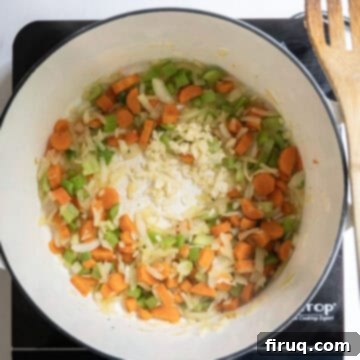
Step 1: Build Your Flavor Base. Begin by heating olive oil in a large Dutch oven or heavy-bottomed pot over medium heat. Once the oil is shimmering, add your chopped carrots, celery, and onion. This trio, known as a mirepoix or soffritto in Italian cooking, is the essential aromatic foundation for your soup. Immediately begin seasoning with a generous pinch of salt, pepper, and dried oregano. Sauté these vegetables, stirring occasionally, for about 8 minutes until they become wonderfully soft and slightly translucent, releasing their sweet aromas. Then, stir in the minced garlic and cook for just another minute until it becomes fragrant – be careful not to burn it.
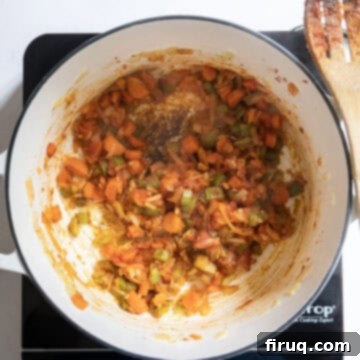
Step 2: Caramelize the Tomato Paste. Once the garlic is aromatic, push the vegetables to one side of the pot and add the tomato paste directly to the exposed bottom. Allow it to cook undisturbed for about 2 minutes. This crucial step encourages the paste to caramelize, deepening and intensifying its natural sweetness and savory notes, creating a more complex tomato flavor for your soup. After caramelizing, stir the tomato paste thoroughly into the vegetables and continue to sauté for another 2 minutes, ensuring all the flavors meld beautifully.
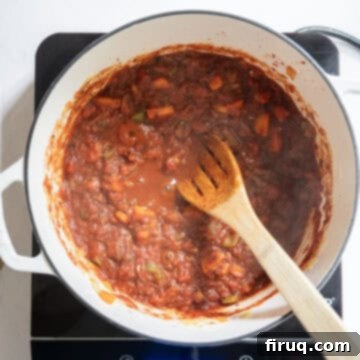
Step 3: Introduce the Tomatoes. Pour in the crushed tomatoes, stirring them well to combine with the caramelized tomato paste and sautéed vegetables. Bring this mixture to a gentle simmer, allowing the flavors to marry for a few minutes. This initial simmer helps to break down the tomatoes and create a rich, integrated base before adding the main liquid.

Step 4: Simmer and Infuse Flavors. Now, add the chicken broth (or vegetable broth for a vegetarian version) to the pot. Stir in the fresh basil, bay leaves, additional oregano, salt, and pepper, adjusting seasonings to your taste. Bring the soup to a full boil, then reduce the heat to a gentle simmer. Add the green beans, zucchini, kidney beans (ensure they are rinsed), and if you have one, a parmesan rind for extra depth of flavor. Cover the pot, leaving a small opening for steam to escape, and let it simmer for 30 minutes, stirring occasionally to prevent sticking and allow all the wonderful flavors to meld and develop.
Step 5: Cook the Pasta. After 30 minutes, remove the cover and add the ditalini pasta directly to the simmering soup. Stir it well to ensure the pasta doesn’t stick together or to the bottom of the pot. Continue to simmer for another 15 minutes, or until the ditalini is perfectly al dente and tender. It’s important to stir often during this stage, as the small pasta shapes tend to sink and can easily get stuck to the pan.
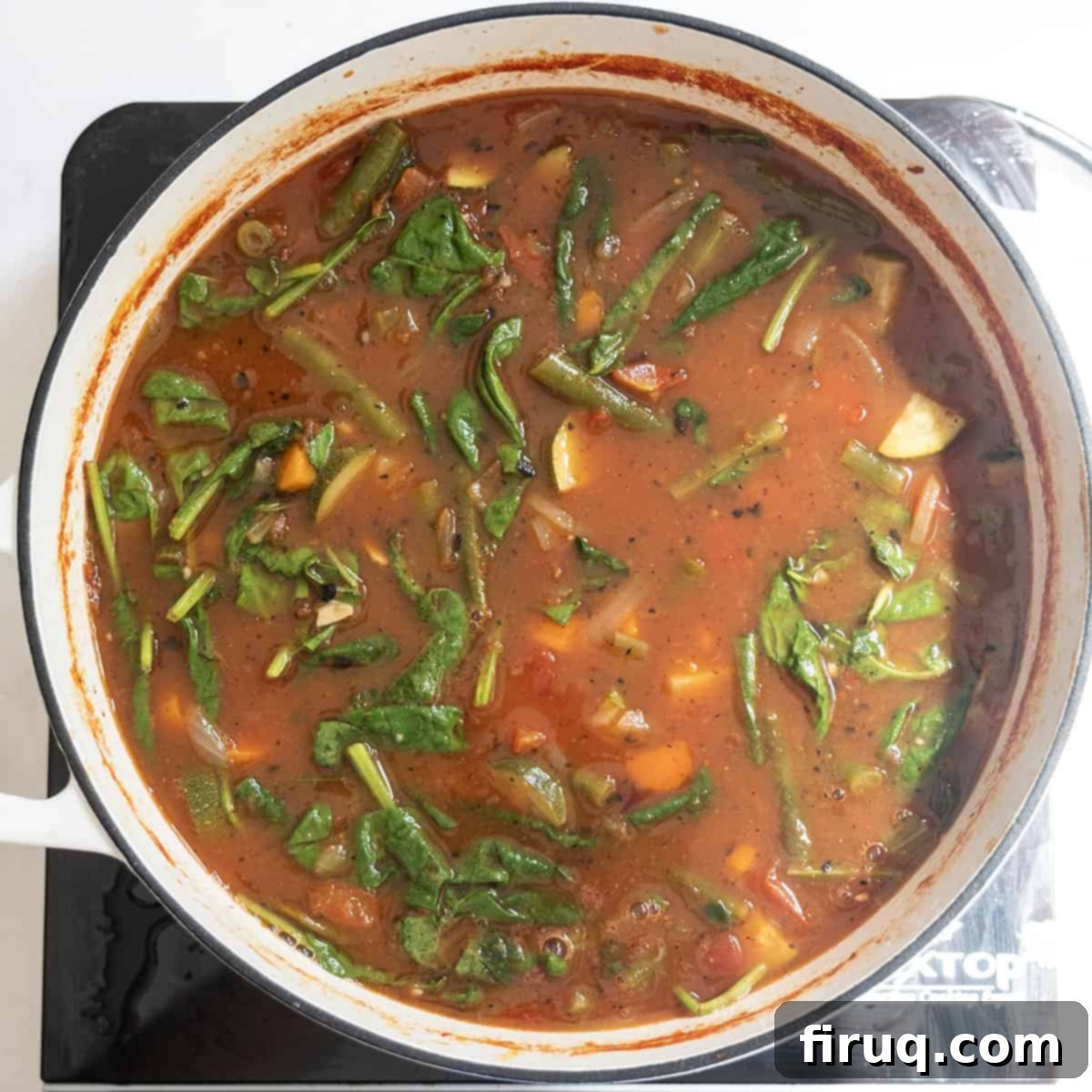
Step 6: Finish with Freshness. For the final touch of freshness and vibrant color, add the spinach to the soup. Cover the pot for just two minutes to allow the spinach to gently wilt from the residual heat. Remove the cover, stir it well throughout the soup, ensuring it’s evenly distributed. Remove the bay leaves and any parmesan rind you added. Serve your glorious Minestrone hot, garnished with freshly grated Parmesan cheese and a side of warm, crusty Italian bread for dipping!
Enhance your meal by serving this delicious soup alongside a savory sandwich like Eggplant Caprese Grilled Cheese or a comforting slice of Pepperoni Bread (Stromboli)!
Pro-Tips for Your Best Minestrone Ever
- Master the Tomato Paste Caramelization. This is a game-changer for deep flavor. When you add the tomato paste, allow it to sit directly on the hot bottom of the pot for 2-3 minutes before stirring it into the vegetables. This process caramelizes its sugars and significantly intensifies the overall tomato flavor in your soup.
- Handle Pasta for Leftovers Smartly. If you anticipate having leftovers or plan on saving a large batch of this soup for later (either in the fridge or freezer), do not cook the ditalini directly in the main pot of soup. Instead, cook the pasta separately according to package directions and add a portion to each bowl just before serving. This prevents the pasta from absorbing all the delicious broth and becoming overly mushy upon reheating.
- Uniform Vegetable Chopping. For even cooking and a consistent texture, make sure to chop your carrots, onions, and celery (your soffritto base) into similar sizes. This ensures they soften at the same pace, preventing some vegetables from being undercooked while others are overcooked.
- Don’t Skip the Parmesan Rind. If you have a leftover parmesan rind, definitely add it to the soup during the simmering stage. It infuses an incredible, subtle umami and nutty depth that elevates the entire dish. Just remember to remove it before serving!
- Adjust Seasoning Throughout. Taste your soup at various stages, especially after adding the broth and again before serving. Vegetables release water, and flavors can change. Adjust salt and pepper as needed to ensure a perfectly seasoned final product.
- Embrace Seasonal Vegetables. Minestrone is a celebration of fresh produce. While our recipe lists specific vegetables, feel free to swap them based on what’s fresh and in season. Kale, potatoes, bell peppers, or even butternut squash can make excellent additions.
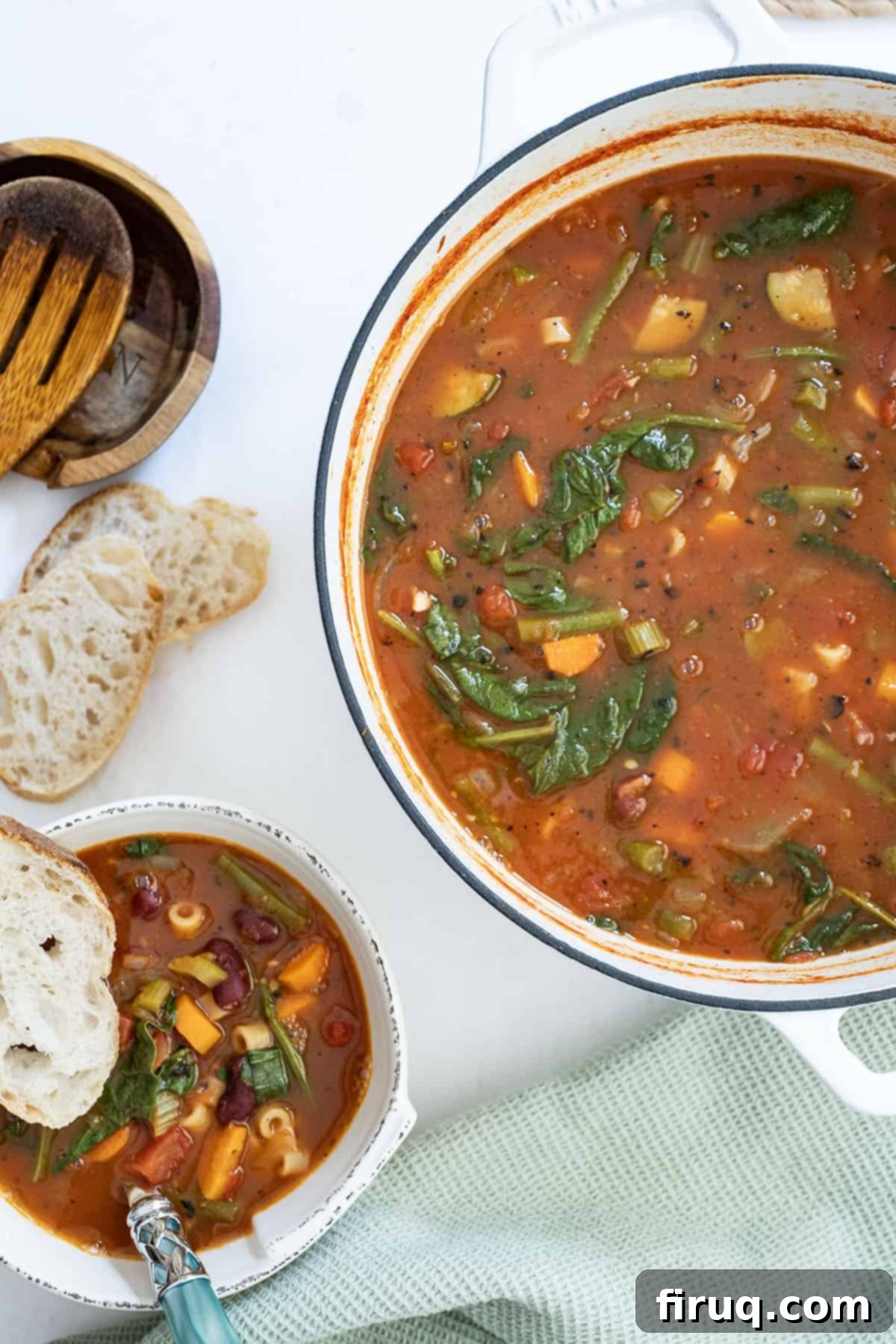
Recipe FAQs: Your Minestrone Questions Answered
This recipe is designed to make a generous batch – often enough for two meals! To store, allow the soup to cool completely before transferring it to airtight containers. It will keep beautifully in the refrigerator for 3-4 days. For longer storage, Minestrone freezes exceptionally well for up to 3 months. When reheating frozen minestrone, you might notice it’s thicker, as the beans and pasta will have absorbed some liquid. Simply add a splash of extra chicken or vegetable broth to reach your desired consistency. Reheat gently on the stovetop over medium-low heat, stirring occasionally, until warmed through. Eating this recipe on day two often yields a thicker, even more flavorful soup as the flavors have had more time to meld.
Absolutely, and I highly encourage it! I incorporate parmesan rinds into almost all of my soups. It’s an excellent way to impart a subtle, salty, and wonderfully nutty umami flavor to the broth without overpowering the other ingredients. Plus, it’s a fantastic “no waste” kitchen hack, allowing you to use every part of your cheese, much like saving vegetable scraps for homemade broth. You simply drop it into the simmering soup and remove it before serving. While it’s certainly not a mandatory ingredient, it adds a layer of complexity that truly enhances the soup’s overall richness.
Yes, absolutely! To make this Minestrone vegetarian, simply use a high-quality vegetable broth instead of chicken broth. For a fully vegan version, ensure you use vegetable broth and either omit the Parmesan rind or use a vegan Parmesan substitute for serving. The rest of the ingredients are naturally plant-based, making it incredibly versatile for different dietary preferences.
Ditalini is a classic choice for Minestrone due to its small size and tube shape, which allows it to nestle perfectly among the vegetables. However, you can easily substitute it with other small pasta shapes like elbow macaroni, small shells, or even broken spaghetti strands. The key is to choose a pasta that won’t overwhelm the soup or become too large when cooked.
If you prefer a thicker soup, you can simmer it for a longer period with the lid off to allow more liquid to evaporate. Alternatively, you can use an immersion blender to blend a small portion of the soup (about 1-2 cups) directly in the pot, then stir it back in. This will naturally thicken the soup without adding extra ingredients. If you find your Minestrone is too thick, simply stir in additional chicken or vegetable broth until it reaches your desired consistency.
Everyone adores a classic Italian Minestrone, unless, of course, they have an aversion to delicious, wholesome vegetables! But let’s be honest, we all need a comforting vegetable soup in our lives from time to time, whether it’s our rich Creamy Mushroom Mascarpone Soup or the robust Barley Lentil Soup!
If you’ve fallen in love with this recipe, make sure to add it to your cooking rotation this year. Feel free to print it below for easy access in your kitchen. We’d also be absolutely thrilled if you left a comment and a review below to let us know what you think. Your feedback is invaluable and helps us create more recipes you’ll love!
More Hearty & Comforting Soups to Explore
If you’re a fan of satisfying soups, you’re in the right place! Here are more delicious recipes to warm your soul and fill your table:
- Rustic Italian Tortellini Soup with Sausage
- White Bean Lentil Soup
- Roasted Carrot Ginger Soup
- Broccoli Rabe and Tortellini Soup
You can follow us on Instagram @vindelgiudice and Tiktok @alwaysfromscratch to see videos and tutorials of our recipes!
📖 Recipe

Classic Italian Minestrone
Vincent DelGiudice
Pin Recipe
Equipment
-
1 Large Dutch Oven
Ingredients
- 8 cups chicken broth
- 2 carrots, chopped
- 2 celery stalks, chopped
- 1 medium onion, chopped
- 3 cloves garlic, minced
- 1 cup green beans, chopped
- 1 zucchini, chopped
- 1 can kidney beans, rinsed
- 1 bag of spinach
- 1 28 oz can crushed tomatoes
- 2 tablespoon tomato paste
- 1 cup ditalini
- 10 basil leaves
- 2 bay leaves
- 2-3 teaspoon salt
- 2 teaspoon pepper
- 1½ tablespoon oregano
- 3 tablespoon olive oil
Instructions
-
In a large Dutch oven or heavy-bottomed pot, heat the olive oil over medium heat until shimmering. Add the chopped carrots, onions, and celery. Season with salt, pepper, and 1 teaspoon of oregano. Stir well and sauté for 8 minutes until the vegetables are soft and slightly translucent. Once soft, add the minced garlic and cook for 1 minute until fragrant. Then, push the vegetables to one side, add the tomato paste to the exposed bottom of the pot, and let it caramelize for 3 minutes before stirring it into the vegetables.
-
Add the crushed tomatoes to the pot and stir to combine everything. Bring the mixture to a gentle boil, then pour in the chicken broth. Bring it back to a boil, then stir in the zucchini, green beans, rinsed kidney beans, fresh basil leaves, bay leaves, the remaining salt, pepper, and oregano. If using, add a parmesan rind. Reduce the heat to a low simmer, cover the pot leaving a small gap for steam to escape, and let it simmer for 30 minutes, stirring occasionally to prevent sticking.
-
After 30 minutes, remove the cover and add the ditalini pasta to the soup. Stir well and continue to simmer for another 15 minutes, or until the ditalini is tender and cooked through. Stir frequently during this stage to prevent the pasta from sticking to the bottom of the pot.
-
Finally, add the fresh spinach to the soup. Cover the pot for 2 more minutes to allow the spinach to wilt from the heat. Remove the cover, stir the spinach well throughout the soup, remove the bay leaves and parmesan rind (if used). Serve your Classic Italian Minestrone hot with freshly grated Parmesan cheese and plenty of crusty Italian bread for dipping. Enjoy!
Notes
- When you add the tomato paste and combine it with the vegetables, allowing it to sit directly on the hot pot surface for a couple of minutes will caramelize the tomato paste and intensely deepen its flavor profile. This step is key for a truly rich Minestrone.
- I prefer to cook my pasta directly in the soup for maximum flavor absorption and a creamy texture. However, if you plan on having leftovers, you may want to cook the pasta separately. This prevents the pasta from soaking up all the soup’s liquid and becoming mushy when stored or reheated. Simply add cooked pasta to individual bowls as you serve.
- For a truly vegetarian Minestrone, remember to substitute chicken broth with vegetable broth and omit the Parmesan rind (or use a vegan alternative for topping).
